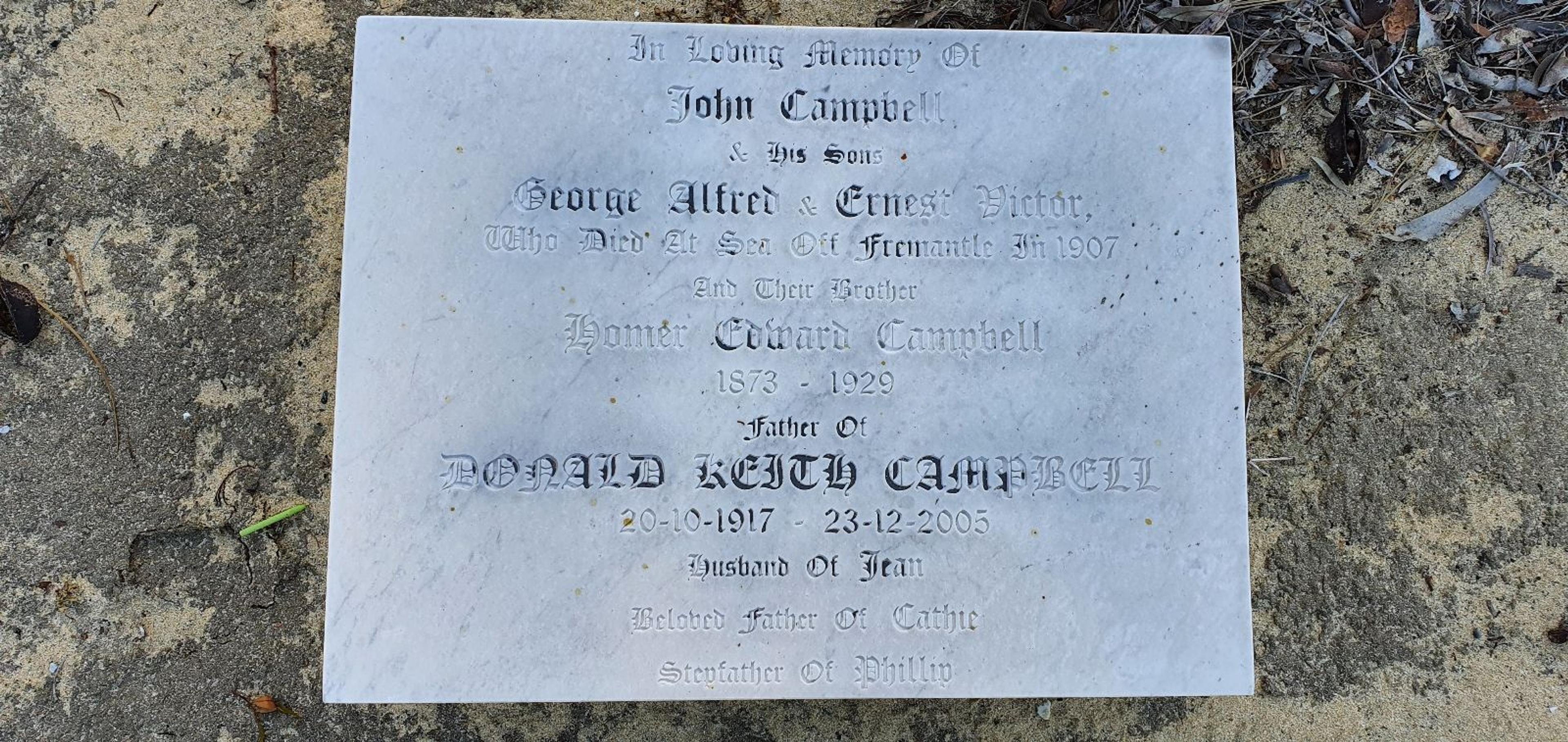Campbell
Vessel Name: Campbell
John Campbell
George Alfred Campbell
Ernest Victor Campbell
Lost at Sea; Bodies never recovered
14 July 1907

Campbell Memorial Plaque
John Campbell was born in Colvend, Kirkcudbright, Scotland in 1843 and married Louisa Mary Ann Keith (born in Shoreditch, London in 1848) in the February of 1873 in Victoria, Australia.
They had seven children, George Alfred and Ernest Victor being two of them. George was born in Fitzroy, Victoria in 1880 and Ernest in Williamstown, Victoria in 1891. It appears from records that the family moved around before finally settling in East Fremantle, Western Australia.
John Campbell was listed on the 1906 East Fremantle Electoral Roll as a ‘Mariner’ living in King Street. Newspaper articles of the day state that he had more than 40 years of experience, although some stated that the Campbell’s were ‘indifferent boatmen’. The tragedy was flagged as a forerunner for other fatalities given the dozens of others using seacraft and no certificates of competency.
The cutter Campbell was seen coming out of Mounts Bay, Fremantle on 14 July and was scheduled to sail north up the coast to Lancelin Island to fish for snapper. The Campbell was a 24 ft. boat, cutter-rigged with a counter stern and copper bottom. By all accounts it was well decked and capable, under proper management, of living through very bad weather. On board that day were father John Campbell and sons George and Ernest. They had onboard enough provisions to last some 14 to 15 days which would indicate that they had planned to be at sea for that length of time before their return to Fremantle.
They were last seen fishing near Lancelin Island on 25 July by another fisherman named Matthews. By Friday, 9 August there were grave concerns for their safety as they had not returned so police patrols were dispatched from Perth, Fremantle and Gingin in the hope that they may be discovered safely sheltering on the beach. It was surmised that due to the very stormy weather they had headed for shelter somewhere along the coast or sheltered under the lee of Lancelin Island waiting for the weather and seas to calm down. A fisherman named Hill, who reached Fremantle on 11 August from a cruise along the coast, informed police that he had sailed some 40 miles north of Lancelin Island putting in at all places where the missing men may have taken shelter. He found no sign of them. He sailed close to Lancelin Island but again did not see any signs of the men or their craft. The information was passed on to the Harbour Master, who, under the circumstances, deemed that it would be futile to send a steamer to search for the missing men. The recent gales and consequent heavy seas gave little hope of finding the men safe.
The search continued and on 13 August Constable Pimblett discovered the missing cutter Campbell wrecked about eight miles north of the Moore River. There was no trace of the men or their bodies. According to the report from Constable Pimblett he thought that the boat must have been wrecked some 50 miles south of Lancelin Island and given the extreme gales and seas it would have been impossible for such a small craft to survive. Given the large amount of seaweed strewn on the beach Constable Pimblett returned to Gingin and advised that until such time as the seas calmed down enough to search the seaweed for bodies it would be a futile exercise.
Mounted patrols from Perth and Fremantle continued to search the beaches and a few days later wreckage was found in the vicinity of the Yanchep Caves. P.C. Patterson reported finding two masts with sail and rope attached on the beach about four miles from the Yanchep Caves.
The 16 ft. masts appeared to have been broken off near the bottom. There was little doubt that the masts and sails formed part of the wrecked boat. The discovery confirmed the fears that were held for the safe return of both boat and crew.
The bodies of John (64), George (27) and Ernest (16) were never found. The health of John’s wife, Louisa, was greatly affected by the loss of her husband and two sons. She died the following year on 19 April 1908 aged 61 years, her funeral being held on Tuesday, 21 April with a burial in the Church of Christ portion of the Fremantle Cemetery. Probate was granted to her eldest son, Homer.
John Campbell’s brother, Captain George Campbell (40), perished when the SS Kanahooka was lost under his command in the Gulf of Carpentaria on 17 January 1894. The Kanahooka was wrecked and George Campbell and some of the crew landed on the Mitchell River, 180 miles from Normanton. George was drowned while attempting to cross the Nassau River in far north Queensland.
